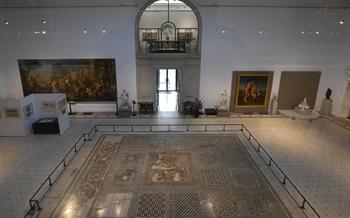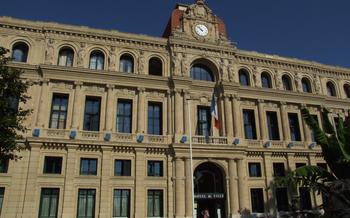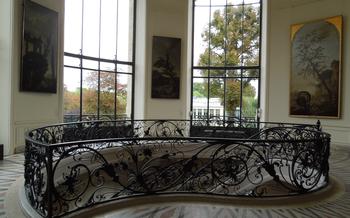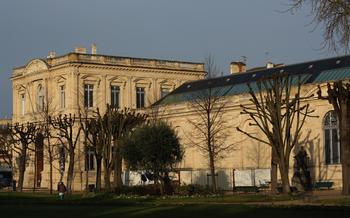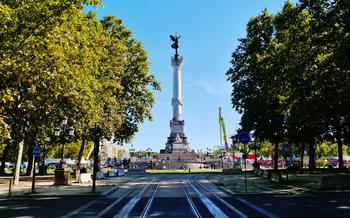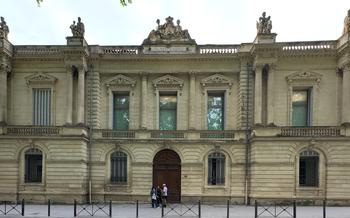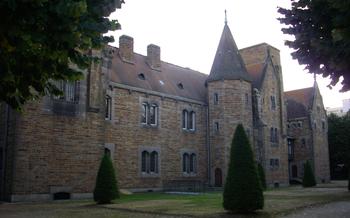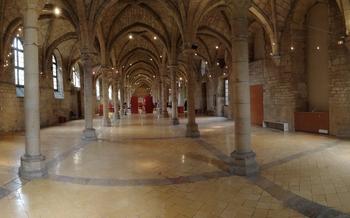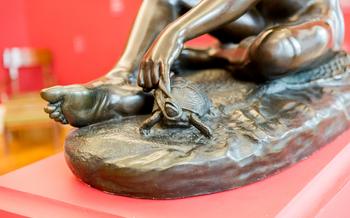
Musée des Beaux Arts de Dijon
- Musée des Beaux Arts de Dijon: An Overview
- A Walk Through Time: Exploring the Museum's History
- Masterpieces Unveiled: Highlights of the Collection
- Navigating the Museum's Layout: Finding Your Way Around
- Admiring the Architectural Splendor: Exploring the Building
- Unveiling the Art of Burgundy: Regional Treasures
- A Journey Through the Centuries: Historical Periods Represented
- Engaging with the Collection: Programs and Activities
- Planning Your Visit: Essential Tips for a Rewarding Experience
- Capturing the Beauty: Photography and Social Media
- Museum Shop and Café: Enhancing Your Visit
- Reaching the Museum: Transportation and Accessibility
- Connecting with the Community: Educational Resources
Musée des Beaux Arts de Dijon: An Overview
The Musée des Beaux-Arts de Dijon is one of the oldest and most prestigious art museums in France. It was founded in 1787, making it one of the first museums established during the French Revolution. The museum is housed in a former palace, the Palais des Ducs de Bourgogne, which was built in the 14th century. The museum's collection includes over 150,000 works of art, ranging from medieval sculpture to contemporary paintings.
The museum's architectural features are as impressive as its collection. The Palais des Ducs de Bourgogne is a masterpiece of Gothic architecture, with its soaring vaults, intricate carvings, and stained glass windows. The museum's interior is equally impressive, with its grand staircases, marble floors, and ornate chandeliers.
The museum's collection is divided into several sections, each dedicated to a different period or style of art. The medieval collection includes sculptures, paintings, and tapestries from the 11th to the 15th centuries. The Renaissance collection features works by some of the most famous artists of the period, including Titian, Veronese, and Tintoretto. The Baroque and Rococo collections include works by Rubens, Van Dyck, and Watteau. The 19th-century collection features works by Delacroix, Ingres, and Courbet.
Practical information: - Hours: The museum is open Tuesday to Sunday from 10am to 6pm. - Admission: Admission is free for all visitors. - Location: The museum is located in the city center of Dijon, at 1 Place de la Sainte-Chapelle.
A Walk Through Time: Exploring the Museum's History
The Musée des Beaux Arts de Dijon has a rich and storied history that spans centuries. Its origins can be traced back to the 18th century when the Academy of Dijon, a learned society, established a collection of artworks. This collection was initially housed in the Hôtel de Ville (City Hall) but was later moved to the Palais des États de Bourgogne, the former seat of the regional parliament.
In the early 19th century, the museum underwent significant expansion under the leadership of its first curator, François Devosge. Devosge acquired numerous works of art, including paintings, sculptures, and decorative objects, from various sources, including private collections, churches, and monasteries. He also played a crucial role in organizing the museum's first public exhibitions.
Throughout the 19th and 20th centuries, the museum continued to grow and evolve. Major renovations and expansions were undertaken to accommodate the growing collection and to improve the visitor experience. In 1876, the museum was moved to its current location, a purpose-built neoclassical building designed by the architect Henri Darcy.
The museum's history is intertwined with several key figures who have made significant contributions to its development. Among them is Georges Chevrier, who served as the museum's director from 1919 to 195Chevrier was instrumental in acquiring important works of art, including paintings by Eugène Delacroix, Gustave Courbet, and Jean-Baptiste Camille Corot. He also organized numerous exhibitions and published several scholarly works on the museum's collection.
The Musée des Beaux Arts de Dijon has also been impacted by historical events. During World War II, the museum was closed to the public and its collection was evacuated to safer locations. After the war, the museum underwent a period of restoration and renovation to repair damages caused by the conflict.
Today, the Musée des Beaux Arts de Dijon stands as a testament to its rich history and its commitment to preserving and showcasing the artistic heritage of Burgundy and beyond. Visitors to the museum can embark on a journey through time, exploring the diverse and fascinating collection that has been carefully assembled over the centuries.
Masterpieces Unveiled: Highlights of the Collection
The Musée des Beaux Arts de Dijon is a treasure trove of artistic wonders, housing a diverse collection that spans centuries and styles. Among the highlights of the permanent collection are several paintings by renowned French and international artists. Visitors can admire works by the Old Masters, such as Rogier van der Weyden's "The Descent from the Cross" and Hans Memling's "The Virgin and Child with Saints and Donors." French masters are also well-represented, with paintings by Nicolas Poussin, Claude Monet, and Gustave Courbet.
Notable sculptures and decorative arts are also on display, including works by François Rude, Antoine Bourdelle, and Jean-Baptiste Carpeaux. The museum's collection of Burgundian art is particularly noteworthy, showcasing the unique artistic heritage of the region. Visitors can explore works by local artists and artisans, depicting regional landscapes and people, providing insights into the cultural identity of Burgundy.
Unique artifacts and hidden gems are scattered throughout the museum, waiting to be discovered by curious visitors. Temporary exhibitions and special displays add to the museum's dynamism, showcasing new perspectives and contemporary art trends. These exhibitions often feature works from renowned artists, both French and international, offering visitors a chance to experience a diverse range of artistic expressions.
Navigating the Museum's Layout: Finding Your Way Around
The Musée des Beaux Arts de Dijon is designed to offer visitors an intuitive and enjoyable experience. Its layout is well-organized, with thematic galleries and sections that guide visitors through different periods and styles of art. Clear signage and maps are provided throughout the museum to help visitors orient themselves and find their way around.
Interactive elements are strategically placed throughout the museum to enhance the visitor experience. Touchscreens and multimedia displays provide additional information about the artworks and their creators. Audio guides are also available for rent, offering visitors a guided tour at their own pace.
The museum's layout allows visitors to explore at their own leisure. Whether you prefer to follow a chronological path through the centuries or focus on specific themes or artists, the museum's design makes it easy to navigate and discover the treasures it holds.
Admiring the Architectural Splendor: Exploring the Building
The Musée des Beaux-Arts de Dijon is housed in a magnificent building that is as much a work of art as the collection it contains. The museum's exterior is a testament to the grandeur of the 18th century, with its elegant facade adorned with intricate carvings and sculptures. The courtyard, with its serene fountain and manicured gardens, provides a tranquil oasis in the heart of the city.
Inside, the museum's interior design is equally impressive. The grand staircase, with its sweeping curves and ornate balustrade, leads visitors to the museum's upper galleries. The walls are lined with decorative moldings and paintings, creating an atmosphere of opulence and sophistication.
While the museum's architecture is predominantly classical, it also incorporates modern elements that blend seamlessly with the historic fabric of the building. Glass panels and skylights allow natural light to flood the galleries, creating a bright and airy atmosphere. Interactive displays and multimedia installations add a contemporary touch, engaging visitors and enhancing their understanding of the artwork.
The Musée des Beaux-Arts de Dijon is a true architectural gem that showcases the harmonious blend of old and new. As you explore the museum, take the time to admire the building's intricate details and appreciate the way it complements the artwork on display.
Unveiling the Art of Burgundy: Regional Treasures
The Musée des Beaux Arts de Dijon takes pride in showcasing the rich artistic heritage of Burgundy, a region steeped in history and cultural traditions. Visitors can immerse themselves in the works of local artists and artisans, gaining insights into the region's unique identity and artistic expressions.
Among the highlights of the Burgundian collection are stunning paintings depicting the region's picturesque landscapes, charming villages, and vibrant people. These artworks capture the essence of Burgundian life, showcasing the region's natural beauty and the daily lives of its inhabitants.
Moreover, the museum houses an impressive collection of sculptures and decorative arts that reflect the region's craftsmanship and artistic techniques. From intricate carvings to finely crafted furniture, these pieces showcase the exceptional skills of Burgundian artisans and their mastery of various media.
By exploring the Burgundian collection at the Musée des Beaux Arts de Dijon, visitors gain a deeper appreciation for the region's cultural heritage and the unique contributions of local artists to the broader French art scene.
A Journey Through the Centuries: Historical Periods Represented
The Musée des Beaux Arts de Dijon boasts a diverse collection that spans various historical periods, offering visitors a journey through the evolution of art and artistic styles. From the Middle Ages to the contemporary era, the museum's galleries showcase masterpieces that reflect the changing artistic movements and influences over the centuries.
The medieval and Renaissance periods are represented by religious works, including paintings and sculptures that depict biblical scenes and saints. These artworks offer a glimpse into the spiritual and artistic sensibilities of the time. The Baroque and Neoclassical periods are characterized by elaborate decorative elements, vibrant colors, and a focus on mythological and historical subjects. Works from the 19th century showcase the Romantic and Realist movements, with paintings that capture the beauty of the natural world and depict everyday life with a keen eye for detail.
Modern and contemporary art movements are also well-represented in the museum's collection. Visitors can find works by renowned artists such as Pablo Picasso, Henri Matisse, and Salvador Dalí, which showcase the diversity of styles and techniques that have shaped modern art. These works challenge traditional notions of art and invite visitors to engage with new perspectives and interpretations.
Engaging with the Collection: Programs and Activities
The Musée des Beaux-Arts de Dijon offers a range of programs and activities to enhance visitors' engagement with the collection. Guided tours led by knowledgeable docents provide in-depth insights into the artworks and their historical context. These tours are available in various languages and can be tailored to specific interests or themes. The museum also hosts workshops and educational programs for all ages, catering to families, students, and adults. These programs include hands-on art-making sessions, interactive workshops, and lectures by experts in the field. Temporary exhibitions and special events further enrich the museum experience, showcasing new acquisitions, spotlighting specific artists or periods, and presenting innovative contemporary art installations. Interactive exhibits, such as touchscreens and multimedia presentations, add an engaging dimension to the visit, allowing visitors to explore the collection in a more immersive way.
Planning Your Visit: Essential Tips for a Rewarding Experience
To make the most of your visit to the Musée des Beaux Arts de Dijon, here are some essential tips:
Recommended Duration: - Allocate at least two to three hours for a comprehensive visit, allowing ample time to appreciate the diverse collection.
Best Time to Visit: - Aim for weekdays and early mornings to avoid crowds, especially during peak tourist season.
With Children: - Engage children with the museum's interactive exhibits and family-friendly programs. Consider bringing sketchbooks or art supplies to encourage creativity.
Accessibility: - The museum offers wheelchair accessibility, ramps, and elevators, ensuring a comfortable visit for all.
Capturing the Beauty: Photography and Social Media
The Musée des Beaux-Arts de Dijon encourages visitors to capture the beauty of the museum and its collection through photography and social media sharing. Designated areas within the museum are marked for photography, allowing visitors to take photos of their favorite artworks and exhibits. The museum also welcomes visitors to share their experiences on social media using hashtags and geotags to connect with others who are passionate about art. By sharing their photos and thoughts online, visitors can contribute to the museum's online community and engage in discussions about the artworks and exhibitions. The museum's social media channels provide a platform for visitors to connect with each other, share their perspectives, and discover new insights into the museum's collection.
Museum Shop and Café: Enhancing Your Visit
The museum shop at the Musée des Beaux-Arts de Dijon is a treasure trove for art enthusiasts and souvenir hunters alike. It offers a wide range of items, including reproductions of famous artworks, art books, postcards, and unique handicrafts inspired by the museum's collection. Visitors can browse through an array of souvenirs to take home a piece of their museum experience, whether it's a memento for themselves or a thoughtful gift for loved ones.
The on-site café provides a welcome respite for weary museum-goers to relax and recharge. Indulge in a delicious selection of light meals, refreshing beverages, and sweet treats while enjoying the tranquil ambiance of the museum's surroundings. Outdoor seating is available during warmer months, allowing visitors to soak up the sunshine and admire the picturesque courtyard.
The museum also offers a range of publications and resources for those who wish to delve deeper into the world of art. These include exhibition catalogs, scholarly journals, and educational materials for visitors of all ages. Whether you're an art history buff, a casual admirer, or simply seeking inspiration, the museum shop and café are essential destinations to enhance your visit to the Musée des Beaux-Arts de Dijon.
Reaching the Museum: Transportation and Accessibility
The Musée des Beaux-Arts de Dijon is conveniently located in the heart of the city, making it easily accessible by various means of transportation. For those arriving by public transport, the museum is a short walk from the Dijon-Ville train station and is well-served by local bus lines. Visitors traveling by car can take advantage of the nearby public parking facilities, ensuring a hassle-free visit.
The museum is committed to providing an inclusive and accessible environment for all visitors. It features ramps and elevators, allowing wheelchair users to navigate the museum's different levels effortlessly. Additionally, the museum offers touch-sensitive exhibits and audio guides in multiple languages, enhancing the experience for visitors with visual or hearing impairments.
Connecting with the Community: Educational Resources
The Musée des Beaux-Arts de Dijon is committed to fostering a love of art and creativity within the local community. Educational programs for schools and groups of all ages provide hands-on experiences, guided tours, and workshops that delve deeper into the museum's collection and art history. Online resources, including virtual exhibitions and educational materials, make the museum's treasures accessible to a wider audience. Through partnerships with educational institutions, the museum promotes art appreciation and encourages the next generation of artists and art enthusiasts. By engaging with the community, the Musée des Beaux-Arts de Dijon becomes a vibrant hub for learning, inspiration, and cultural exchange.
